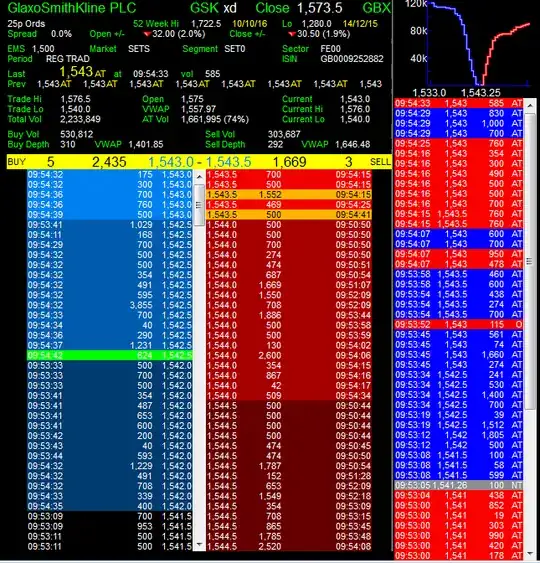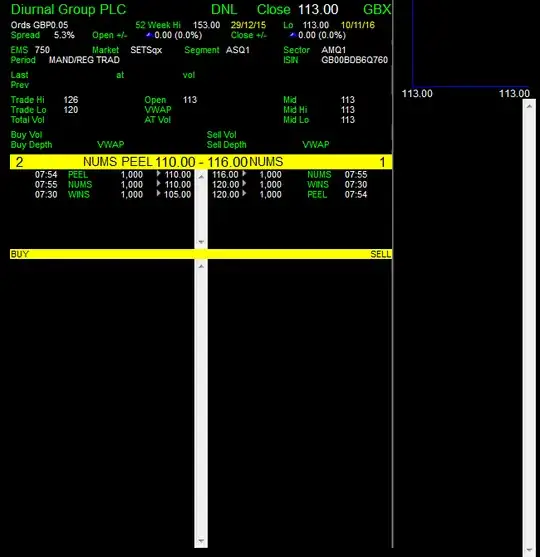Can I sell a stock immediately at the price of the market or is there a chance that no one would want to buy at that exact time/price thus causing me not to be able to sell?
6 Answers
You have no guarantees. The stock may last have traded at $100 (so, the market price is $100), but is currently in free-fall and nobody else will be willing to buy it for any more than $80. Or heck, maybe nobody will be willing to buy it at all, at any price. Or maybe trading on this stock will be halted.
Remember, the market price is just what the stock last traded at.
If you put in a 'market order', you are ordering your broker to sell at the best available current price. Assuming someone's willing to buy your stock, that means you'll sell it. But if it last traded at $100, this doesn't guarantee you'll sell at anything close to that.
- 14,143
- 1
- 45
- 75
In order to see whether you can buy or sell some given quantity of a stock at the current bid price, you need a counterparty (a buyer) who is willing to buy the number of stocks you are wishing to offload. To see whether such a counterparty exists, you can look at the stock's order book, or level two feed.
The order book for liquid stocks.
The order book shows all the people who have placed buy or sell orders, the price they are willing to pay, and the quantity they demand at that price. Here is the order book from earlier this morning for the British pharmaceutical company, GlaxoSmithKline PLC.
The buy side.
Let's start by looking at the left-hand blue part of the book, beneath the yellow strip. This is called the Buy side. The book is sorted with the highest price at the top, because this is the best price that a seller can presently obtain. If several buyers bid at the same price, then the oldest entry on the book takes precedence.
You can see we have five buyers each willing to pay 1543.0 p (that's 1543 British pence, or £15.43) per share. Therefore the current bid price for this instrument is 1543.0. The first buyer wants 175 shares, the next, 300, and so on. The total volume that is demanded at 1543.0p is 2435 shares.
This information is summarized on the yellow strip: 5 buyers, total volume of 2435, at 1543.0.
You can sell a small number of shares instantly at the current bid price.
These are all buyers who want to buy right now and the exchange will make the trade happen immediately if you put in a sell order for 1543.0 p or less. If you want to sell 2435 shares or fewer, you are good to go.
Trading larger quantities of stocks may not be possible at the advertised bid price.
The important thing to note is that once you sell these bidders a total of 2435 shares, then their orders are fulfilled and they will be removed from the order book. At this point, the next bidder is promoted up the book; but his price is 1542.5, 0.5 p lower than before. Absent any further changes to the order book, the bid price will decrease to 1542.5 p. This makes sense because you are selling a lot of shares so you'd expect the market price to be depressed. This information will be disseminated to the level one feed and the level one graph of the stock price will be updated.
Thus if you have more than 2435 shares to sell, you cannot expect to execute your order at the bid price in one go. Of course, the more shares you are trying to get rid of, the further down the buy side you will have to go.
In reality for a highly liquid stock as this, the order book receives many amendments per second and it is unlikely that your trade would make much difference. On the right hand side of the display you can see the recent trades: these are the times the trades were done (or notified to the exchange), the price of the trade, the volume and the trade type (AT means automatic trade).
Trading illiquid instruments.
GlaxoSmithKline is a highly liquid stock with many willing buyers and sellers. But some stocks are less liquid. In order to enable traders to find a counterparty at short notice, exchanges often require less liquid stocks to have market makers. A market maker places buy and sell orders simultaneously, with a spread between the two prices so that they can profit from each transaction.
For instance Diurnal Group PLC has had no trades today and no quotes. It has a more complicated order book, enabling both ordinary buyers and sellers to list if they wish, but market makers are separated out at the top. Here you can see that three market makers are providing liquidity on this stock, Peel Hunt (PEEL), Numis (NUMS) and Winterflood (WINS). They have a very unpalatable spread of over 5% between their bid and offer prices. Further in each case the sum total that they are willing to trade is 3000 shares. If you have more than three thousand Dirunal Group shares to sell, you would have to wait for the market makers to come back with a new quote after you'd sold the first 3000.
- 210
- 1
- 5
If you place a market order, you are guaranteed to sell your stock unless the stock is in a trading halt. A market order does not guarantee the price you sell the stock at.
If you place a market order, even if the stock is very illiquid a market maker will guarantee a market, but will not guarantee a price.
- 141
- 7
You can*, if the market is open, in a normal trading phase (no auction phase), works, and there is an existing bid or offer on the product you want to trade, at the time the market learns of your order.
Keep in mind there are 2 prices: bid and offer. If the current bid and current offer were the same, it would immediately result in a trade, and thus the bid and offer are no longer the same.
Market Makers are paid / given lower fees in order to maintain buy and sell prices (called quotes) at most times.
These conditions are usually all true, but commonly fail for these reasons:
- Market makers pull their quotes e.g. because in 1 minute there's a timed announcement by a relevant central bank.
- Market makers pull their quotes because of a large amount of buy (resp. sell) orders resulting in runaway prices.
- The market's servers hosting your stock crashed (way more common than you think, happens several times a year).
Most markets have an order type of market order that says buy/sell at any price. There are still sanity checks put in place on the price, with the exact rules for valid prices depending on the stock, so unless it's a penny stock you won't suddenly pay ten times a stock's value.
*The amount you can buy sell is limited by the quantity that exists on the bid and offer. If there is a bid or offer, the quantity is always at least 1.
- 2,125
- 1
- 11
- 11
You can always trade at bid or ask price (depending if you are selling or buying). Market price is the price the last transaction was executed at so you may not be able to get that. If your order is large then you may not even be able to get bid/ask but should look at the depth of the order book (ie what prices are other market participants asking for and what is the size of their order).
Usually only fast traders will trade at bid/ask, those who believe the price move is imminent. If you are a long term trader you can often get better than bid or ask by placing a limit order and waiting until a market participant takes your offer.
- 798
- 6
- 13
Yes you can, provided if buyers are available. Normally high liquidty stocks can be sold at market prices a little higher or lower.
- 29
- 3

